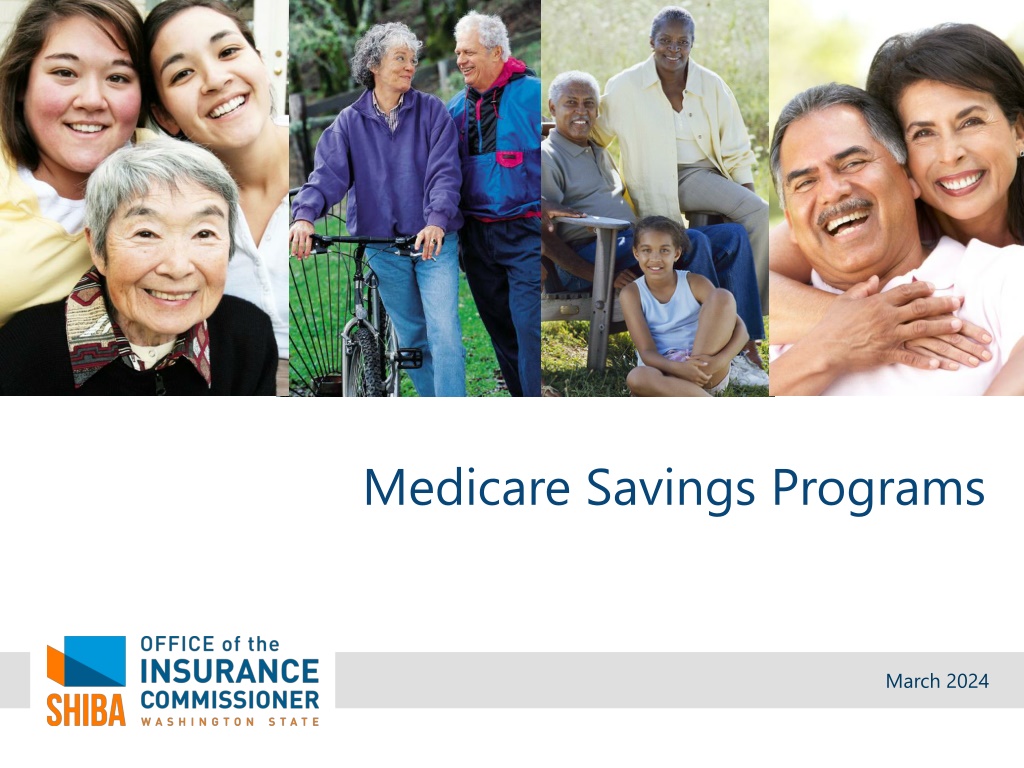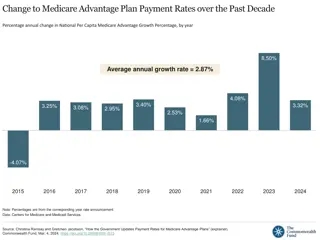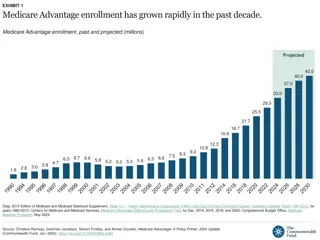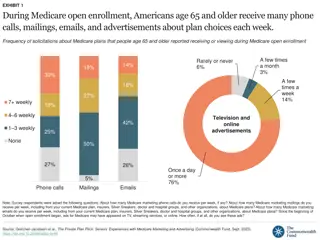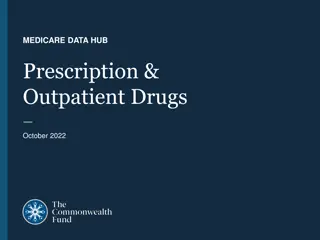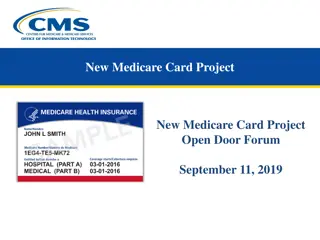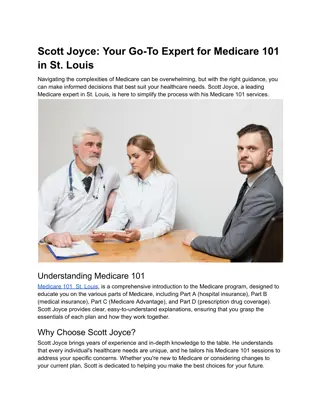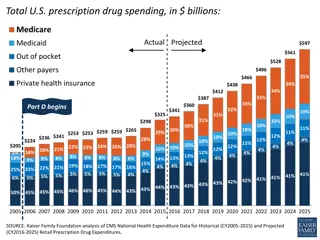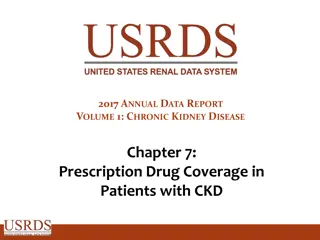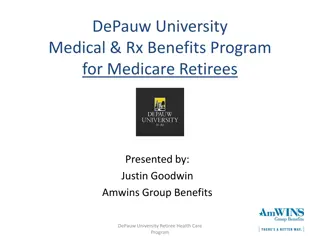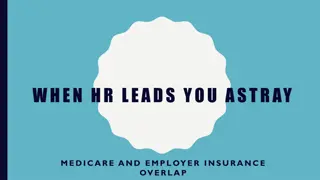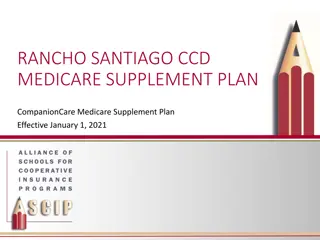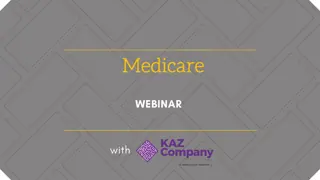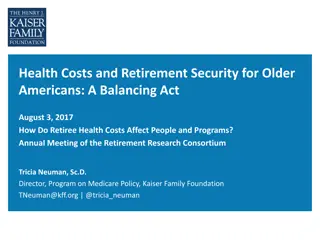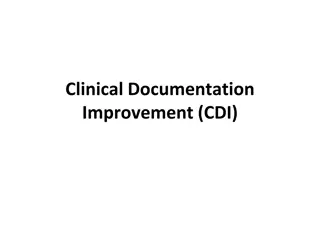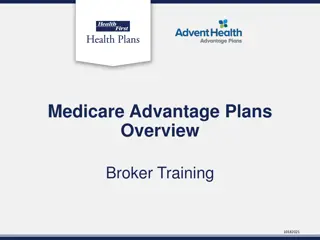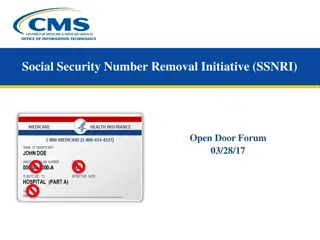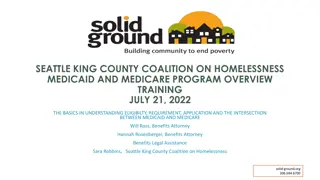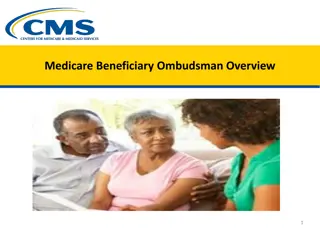Understanding Medicare Savings Programs - A Comprehensive Guide
Explore the intricacies of Medicare Savings Programs (MSP) through this detailed presentation. From tools and rules to eligibility criteria, learn about the different MSP options like QMB and SLMB and how they assist with Medicare costs. Discover the income limits, benefits, and application process, empowering counselors to explain MSP benefits to clients effectively.
Download Presentation

Please find below an Image/Link to download the presentation.
The content on the website is provided AS IS for your information and personal use only. It may not be sold, licensed, or shared on other websites without obtaining consent from the author. Download presentation by click this link. If you encounter any issues during the download, it is possible that the publisher has removed the file from their server.
E N D
Presentation Transcript
Medicare Savings Programs March 2024
Materials This PowerPoint presentation. Workbook. Rainbow Chart. Medicare Savings Programs 2
Housekeeping There will be specific question times. Mute your microphone. Use the "raise your hand" function for questions. Limit your questions to the material we are covering. Medicare Savings Programs 3
A glimpse of whats to come Section 1: Tools & rules Section 2: Income Section 3: Household size Section 4: MSP application process Section 5: Counseling session prep Section 6: Counseling session Section 7: Conclusion Medicare Savings Programs 4
Learning outcomes Learning outcomes: Counselors will be able to explain to clients the benefits provided by Medicare Savings Program (MSP). Counselors will be able to articulate the eligibility criteria for the MSP. Medicare Savings Programs 5
Section 1: Tools & rules Rainbow Chart Medicare Savings Programs 6
What is a Medicare Savings Program? Medicare Savings Program (MSP): MSPs are state programs that assist with paying Medicare costs. These are assistance programs, not insurance plans. Medicare Savings Programs 7
Qualified Medicare Beneficiary (QMB) Here is some important information about QMB: Pays Part A and Part B premiums. Pays deductibles. Pays co-payments except for prescriptions. To be eligible, your income must be no more than: 110% of the Federal Poverty Level (FPL). Medicare Savings Programs
Specified Low-income Medicare Beneficiary (SLMB) Here is some important information about SLMB: Pays Part B premiums. To be eligible, your income must be no more than: 120% of FPL. Medicare Savings Programs 9
Qualified Individual (QI-1) Here is some important information about QI-1: Pays Part B premiums. To be eligible, your income must be no more than: 138% of FPL. Medicare Savings Programs 10
SHIBA job aid: Rainbow Chart Medicare Savings Programs 11
Case-scenario Sarah, a 72-year-old retiree, is navigating her retirement years on a fixed income. Her annual income is $18,000. What kind of assistance is she eligible for? Rainbow Chart Medicare Savings Programs 12
SLMB features If you are enrolled in the SLMB program, you may receive up to three months of retroactive reimbursement for Part B premiums. For example, if you submitted an MSP application at the end of 2024 and are approved for February 2025, you may be reimbursed for premiums paid in November and December of 2024, as well as January 2025. Medicare Savings Programs 13
Section 2: Income Medicare Savings Programs 14
Income The monthly income limits for the MSPs are based on a percentage of the FPL rates that are published each year in the Federal Register. If someone asks about the other MSP s (QMB, SLMB, QI) and has earned income, apply the Social Security Income (SSI) earned income exclusions. (HI 00815.023 Medicare Savings Programs Income Limits) Medicare Savings Programs 15
What counts as an income? Income is anything you receive during a calendar month and can use to meet your needs for food or shelter. It may be cash or in- kind. In-kind income is not cash; it is food or shelter, or something you can use to get food or shelter. Medicare Savings Programs 16
Not income Here are some examples that do not count as income: Food stamps. Cash loans that you have agreed to repay. Income tax refunds. Home energy assistance. Medicare Savings Programs 17
Not income Here are some more examples that do not count as income: Food or shelter provided by a nonprofit agency. Money spent by others on your expenses, including your phone bills, utility bills, or medical bills (anything other than food and shelter). Medicare Savings Programs 18
Section 3: Household size Medicare Savings Programs 19
MSP income eligibility: FLP & household FPL standard is based on family size. The dollar amount increases as the family size increases. For purposes of determining eligibility for subsidy, family size is determined as follows: The number of individuals that count for family size include: The client (1-person household provide further assistance). The client's spouse who lives with the client; (2-person household provide further assistance). The client's dependents who live with the client and all other more complex situations (Refer to DSHS). Medicare Savings Programs 20
Two-person household The client and the client's spouse who lives with the client. The same rule applies whether only the individual files, or both spouses file for subsidy. Medicare Savings Programs 21
Example Rebecca and Rick Johnson are married and live together. Nobody else lives with them. Rick, age 67, applies for the MSP. Rebecca is not old enough for Medicare and is not applying. For purposes of determining subsidy, the family size is____________. Medicare Savings Programs 22
Section 4: MSP Application Process Medicare Savings Programs 23
Application: screening & assistance What do SHIBA volunteers do? Screen for income, as well as provide application assistance. What does DSHS do? Review applications and send eligibility determination letters. Medicare Savings Programs 24
Application assistance Tips for assisting clients: If you are comfortable with using online technology, please assist the client using WA Connection. Here is an instructional video from Washington State Department of Social and Health Services. Medicare Savings Programs 25
Application referrals Referrals: Please see Appendix D in your workbook for the list of local organizations. Medicare Savings Programs 26
Section 5: Counseling session prep Medicare Savings Programs 27
Counseling session scenario Counseling session scenario: Laura is 67 years old and lives in Pierce Co. She is currently enrolled in a Medicare Advantage plan. She's calling because she is struggling to pay her Part B premium. You are preparing to return a call to Laura. Medicare Savings Programs 28
Preparing for a counseling session with Laura You are a counselor preparing to return a call to Laura. Consider these questions: What do you do to prepare for this session? What information do you need to convey? What is within your scope as a counselor for this session? Medicare Savings Programs 29
Section 6: Counseling session Medicare Savings Programs 30
Counseling scenario Laura is 67 years old and lives in Pierce Co. She is currently enrolled in a Medicare Advantage plan. She's calling because she is struggling to pay her Part B premium. Audio Recording Medicare Savings Programs 31
Eligibility screening checklist Income Eligibility Screening Medicare Savings Programs 32
Section 7: Conclusion Medicare Savings Programs 33
Learning outcomes Learning outcomes: Counselors will be able to explain to clients the benefits provided by MSP. Counselors will be able to articulate the eligibility criteria for the MSP. Medicare Savings Programs 34
Learning outcomes assessment Learning outcomes assessment: Do you feel more confident explaining to clients the benefits provided by MSP? Do you feel more confident articulating the eligibility criteria for MSP? Medicare Savings Programs 35
Tell us what you think about: Today's topic. New training format (more hands-on). Workbook usefulness. Case suggestions. Training topic suggestions. Income counseling checklist. OICMedicareTrainingFeedback@oic.wa.gov Medicare Savings Programs 36
Announcements & resources Medicare Savings Programs 37
Senior Medicare Patrol information session Is it fraud or a complaint? How do I know? What steps do I take? Tuesday, March 26th from 3:00-4:00pm Where: Zoom Meeting https://wa-oic.zoom.us/j/85334966441 Who is this for? Any SHIBA counselor! Presented by: Kim McKenna, SMP Coordinator Medicare Savings Programs 38
First Thursday Lunch and Learn 1st Thursdays - 11:00 to Noon Register through monthly training calendar March 7- D-SNPs Johnny Shults, DSHS April 4 - Medicare Enrollment Kirk Larson, Social Security Administration May 2 MSP Determinations & Buy-ins Deena Best & Angie Gonzales DSHS Have questions? Send in advance to: Noreen.Brisson@oic.wa.gov Medicare Savings Programs 39
Resources Medicare Savings Programs (MSP) 2024 Medicare Quick Reference job aid HCA: WA Medicaid Rules SLMB at Medicare Interactive Primer on MSP's: Benefits Legal Assistance (Solid Ground) Medicare Applications for Assistance - Special Situations Medicare Savings Programs 40
Resources Medicaid Eligibility Overview (HCA) SSA Program Operations Manual System (POMS) LGBT Aging Center Washington Connection Coordination of benefits | Washington State Health Care Authority Medicare Savings Programs Desk Aid Understanding SSI Income Medicare Savings Programs 41
Glossary Medicare Savings Programs (MSP) help paying your Medicare Part A (Hospital Insurance) and Part B (Medical Insurance) premiums. If you qualify, Medicare Savings Programs might also pay your Part A and Part B deductibles, coinsurance, and copayments. Qualified Medicare Beneficiary (QMB) Helps pay for: Part A premiums; Part B premiums, deductibles, coinsurance, and copayments (for services and items Medicare covers). Specified Low Income Medicare Beneficiary (SLMB) Helps pay for: Part B premiums (You must have both Part A and Part B to qualify.) Qualified Individual (QI-1) Helps pay for: Part B premiums (You must have both Part A and Part B to qualify.) Medicare Savings Programs 42
2024 Medicare quick reference job aid Medicare Savings Programs 43
